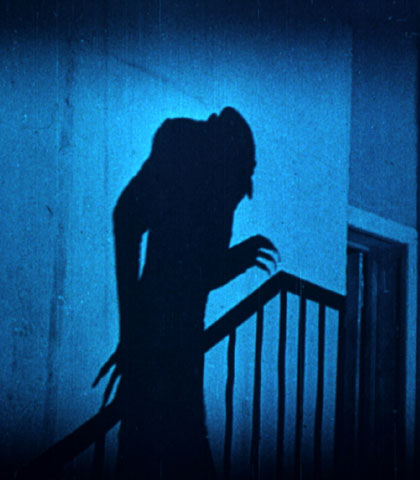
written by Brenda Hineman
Freddy Krueger, Michael Myers, Jason Voorhees... these horror legends have helped to define the modern era of horror. Before all of them - hell, even before movies had sound - there was the original bogeyman: Count Orlok.
From the horror classic - Nosferatu, eine Symphonie des Grauens - comes Count Orlok. Played by the extremely creepy Max Schreck, Count Orlok is a very thinly disguised Count Dracula. In fact, Nosferatu is an interpretation of Dracula that was just different enough to avoid a lawsuit from the estate of Bram Stoker.
While there are a handful of Dracula films that have come out over the years, perhaps none are more compelling than Nosferatu. Director, F.W. Murnau, worked what we know refer to as the German Expressionist style to its fullest potential. The style of film direction lent itself personally to a Dracula film. Whereas modern horror films rely heavily on special effects and talented makeup departments, Nosferatu was created using the most basic effect of horror: darkness and light. The black and white filming, if used today, would be considered a stroke of brilliance, when other films are racing for IMAX and 3D.

Further, Stoker's original Dracula is very well-suited to a silent film. Told largely in journal entries, it is short on dialogue and big on observations. To his credit, Murnau recognized the potential of a Dracula screen adaptation in the infancy of motion pictures. Potential alone, however, does not make for a masterpiece. Indeed, every horror flick needs a convincing performance from its lead actor; enter Max Schreck.
At the time he took the roll of Count Orlok in Nosferatu, Schreck was still early in his career. His secondary roles in films like Der Richter von Zalamea and Der zeugende Tod paled in scope compared to the role of Orlok. Still, Schreck's early years on the stage prepared him wonderfully. Schreck's use of body language, whether creeping through the castle or rising from a coffin define spooky. His facial expressions walk the line between human and animal - between mortal and immortal.
The combination of Schreck's acting and Murnau's artistic direction really come to life, however, against the filming location. Rather than building elaborate sets to exacting standards, Murnau did was nearly unthinkable at the time: he filmed on location. Moving the entire filming operation to the same Carpathian Mountains that Stoker's original story was set in proved to be the perfect choice. In that respect, the mountains proved to be another character in their own right.

In total, what Nosferatu teaches us more than 80 years after its initial release is that the elements of horror are more organic than we may have come to believe. With no gore, no computer generated graphics, and very little makeup, Nosferatu stands as one of the most powerful horror films ever made.
--Brenda Hineman
(Brenda Hineman is a horror movie fanatic. When she's not having the bejeebers scared out of her, she writes about Halloween Costumes at StarCostumes.com.
